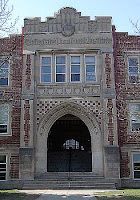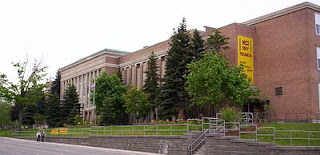In 1971, both Peterborough and Guelph were the same size – about 60,000. Both were home to recently incorporated universities, adding new dimensions to their economies based on a mix of agriculture and manufacturing. Since then Guelph has been growing at the rate of 2% per year – twice that of Peterborough. As a result, the population of Guelph has doubled in the forty-year period, and is now about 120,000.
Much of this development has to do with the University of Guelph, located at what was not long ago the south end of the city – the inverse of Trent’s situation at the north end of Peterborough. Because the south end of Guelph is nearest highway 401, and the university has been the city’s primary economic engine, the southward sprawl in the past twenty years has been unstoppable, turning prime farmland into housing tracts and strip malls at a disturbing rate – an ironic effect of the high-power agri-biz sector now associated with the university and its 140-year-old agricultural college.
In spite of the sprawl, which has spoiled many of Ontario’s urban areas, Guelph remains known as one of the most desirable places to live in the province, with a reputation for a high standard of living, low crime rates, and community integrity. The city has managed to respect its heritage while allowing for continued growth, preserving many nineteenth-century stone buildings downtown, including its city hall, and became well-known for resisting the invasion of WalMart, as documented here.
 The city’s original high school, Guelph Collegiate and Vocational Institute, has been on its present site in a residential neighbourhood just over one kilometer west of city hall since 1854. The current building dates from 1923. Local authorities over the past century repeatedly opted to expand the facilities to accommodate the city’s growing population. GCVI is fully-enrolled and has developed an excellent reputation.
The city’s original high school, Guelph Collegiate and Vocational Institute, has been on its present site in a residential neighbourhood just over one kilometer west of city hall since 1854. The current building dates from 1923. Local authorities over the past century repeatedly opted to expand the facilities to accommodate the city’s growing population. GCVI is fully-enrolled and has developed an excellent reputation.  GCVI is within easy walking distance of the core commercial area and is not separated from it by any major thoroughfares or geographical barriers. The school has been a powerful neighbourhood anchor attracting and retaining educated, middle-class families, who have been motivated to keep their century homes renovated and their properties cultivated. Guelph is perennially a leader in the "Communities in Bloom" initiative, and is one of Ontario’s most beautiful cities to walk through in the spring and summer.
GCVI is within easy walking distance of the core commercial area and is not separated from it by any major thoroughfares or geographical barriers. The school has been a powerful neighbourhood anchor attracting and retaining educated, middle-class families, who have been motivated to keep their century homes renovated and their properties cultivated. Guelph is perennially a leader in the "Communities in Bloom" initiative, and is one of Ontario’s most beautiful cities to walk through in the spring and summer. Aiding in this effort are two older elementary schools. On the walking route from GCVI to the downtown is Central Public School. Instead of demolishing it when it needed repairs in the late 60s, the school board rebuilt it, and it now shares its space with the Continuing Education programs of both the separate and public boards in an innovative partnership. About 1.8 km north is another heritage school, Victory Public. Built in 1918 and expanded in 1953, the school features brass rails, wooden floors and old-fashioned cloakrooms. Its board webpage calls it “the pride of the community.”
Follow the Speed River out of Guelph to where it flows into the Grand, and you’ll find yourself in Cambridge, another mixed manufacturing and agricultural area that has experienced significant expansion in recent decades and is now home to more than 120,000 people. The city was created in 1973 by the amalgamation of the former towns of Galt, Preston and Hespeler. Each of these three small centers had its own secondary school and commercial area. Since the amalgamation, much development has occurred between the old cores and well beyond them. Yet the original high schools of Galt, Hespeler and Preston have been preserved.
Galt CIVS, established in 1852, was expanded in the early 1960s and again in the late 1980s. Students continue to flock to the heritage building, located on the east bank of the river and joining old downtown Galt to the residential areas just north. Rather than open a massive suburban school to serve baby boomers, the board at the time opted to split the difference, expanding Galt CIVS and building a more moderately-sized school, Southwood, to serve the growing west end.
About 6 km upriver you’ll find Preston High, in the center of old Preston. Built in 1934, the school currently draws many enriched students through its doors and remains highly enrolled. Completing the triangle, about 7 km north-east, across the 401, is Jacob Hespeler Secondary, a newer facility built just a few blocks from historic Hespeler village, another community which has aimed to preserve its heritage, in one instance by encasing its Carnegie-era library in a modern glass structure rather than tearing it down. All three areas have maintained public elementary schools in their cores as well.
Cambridge’s schools are operated by the Waterloo Region District School Board, which also governs schools in Kitchener-Waterloo. In 2003, the board proposed to downsize its facilities by closing both Southwood in Cambridge and Kitchener-Waterloo Collegiate and Vocational School – popularly known as KCI (Kitchener Collegiate Institute).
Founded in 1855, KCI has been at its current location right near the border between Kitchener and Waterloo since 1874. Eleven additions have since been made, with the oldest part of the building today dating from 1903 – about the same age as PCVS. In the 1970s, the city of Kitchener designated the front foyer as a heritage structure.
The proposed closures prompted a negative reaction among citizens. According to Wikipedia, “KCI had significant history and a unique culture among secondary schools in Kitchener and Waterloo” due in part to the “wide variety of socio-economic and cultural backgrounds among its students.” In response to community pressure, the school board re-evaluated their finances and found a way to keep both KCI and Southwood open.
 |
| KCI - the heart of Kitchener-Waterloo |
The current KCI school slogan is “Urban Heritage – Global Learning.” Their website calls KCI “an essential and integral part of Kitchener-Waterloo,” and declares the school’s pride in being a “welcoming and tolerant educational institution representing all the worlds’ people and all the worlds’ abilities.” KCI aims to take a diverse collection of students and turn them into “active, caring, engaged, healthy members of a community in which they feel respected, responsible and safe.” Their goal is for students, staff and community to become “ONE KCI”.
 |
| Elizabeth Ziegler PS |
Sound anything like PCVS?
Oh, and their school teams are known as the Raiders. And a former Prime Minister, William Lyon Mackenzie King, went to school there.
KCI isn’t the only heritage school maintained in the core of the twin cities. Around the corner on the Waterloo side is Elizabeth Ziegler Public School, dating from 1931 and designated a heritage site in 1985. To the east is the elementary school MacKenzie King attended, Suddaby Public School, founded in 1857 with its current building dating from 1922. It was designated a heritage building in 1980.
 Waterloo is of course the home of the University of Waterloo, which has helped the area’s economic development immensely. The city’s prosperity in recent years has also been in no small part due to the success of Research in Motion, creators of the Blackberry, whose annual global sales are in the billions of dollars.
Waterloo is of course the home of the University of Waterloo, which has helped the area’s economic development immensely. The city’s prosperity in recent years has also been in no small part due to the success of Research in Motion, creators of the Blackberry, whose annual global sales are in the billions of dollars. Who was the man who helped direct RIM to its stratospheric success? None other than PCVS graduate Jim Balsillie, one of the most successful Canadian entrepreneurs of all time.
Naturally, the university has been a big draw for high-tech companies. But so has the city’s community integrity and attractiveness. With a population of about 100,000, Waterloo has maintained its own walkable “uptown” city center and neighbourhood feeling against both the pressures of suburban sprawl and the bigger “downtown” of adjacent Kitchener, a municipality twice its size. Preserving central heritage schools has been a big part of this effort.
On the other side of the border, Kitchener has battled urban blight proceeding from the downturn of its manufacturing sector with major redevelopment projects. Unlike the situations in Welland and Sault Ste. Marie, these efforts are already succeeding, thanks in no small part to the sensible decision by the Waterloo Region school board to maintain the city’s central heritage high school, KCI.
If only KPR administrators were as enlightened as their Waterloo Region counterparts, Peterborough might have a shot at becoming the next Waterloo, instead of the next Welland.

Teaching in worldwide academic institutions may be broadly obtainable but it seems to be more tough to be employed into because of the superior requirements important for instructors and even educating employees. Among the normal requirements is the comprehension and fluency of more than a person terminology, usually the nationwide terminology, and then an international terminology. English is also not restricted to educating English as such, but educating English as a Second Language (ESL).
ReplyDeleteCambridge Schools in Hyderabad
International Schools in Hyderabad